|
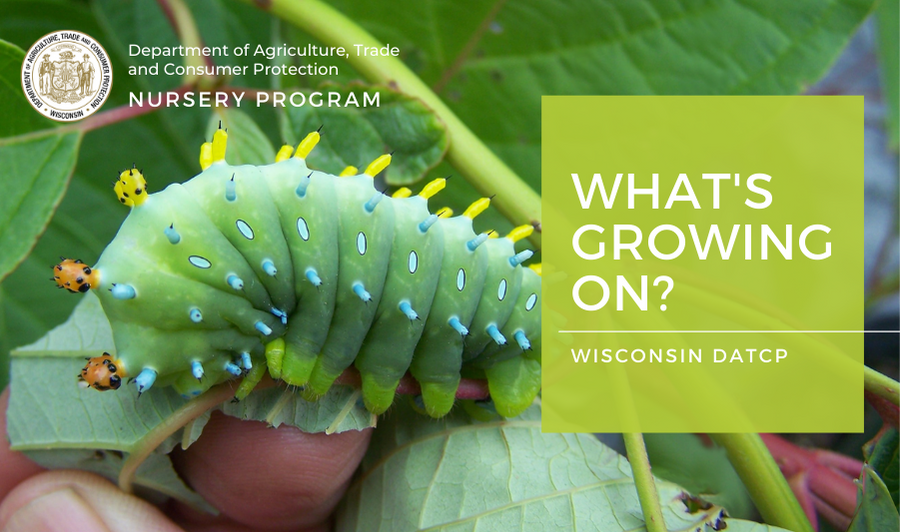 _____________________________________
Dear Wisconsin nurseries, Christmas tree growers, and gardeners:
Now that growing degree days (GDD) have started accumulating, I think we can say that spring is here! GDD (simple B50) as of April 13 were 34 in Bayfield, 48 in Medford, 52 in Wausau, 65 in Hancock, 68 in Madison, 70 in Green Bay, 74 in Racine, and 84 in La Crosse.
Take a moment to read through a few updates from the DATCP nursery and other Plant Protection programs. Please send any feedback, questions, or ideas for future e-news updates to datcpnursery@wisconsin.gov.
Having trouble viewing this email? View it as a Web page.
_____________________________________
|
|

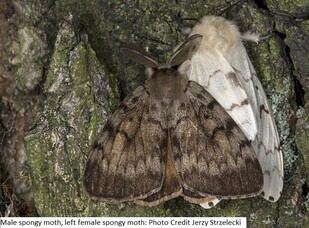
Because the spongy moth is now well-established in Douglas County, APHIS and DATCP added this county to the state and federal quarantine on April 10, 2023, joining the eastern 2/3 of the state that is already regulated and infested with this pest. Trapping data indicated that populations had been increasing in Douglas County for the past 3 years, with 1,545 male moths caught by DATCP staff baited pheromone traps in 2020, 3,482 in 2021, followed by a sharp increase to 15,375 in 2022. This data, along with egg mass detections in the city of Superior, the 80,000 acres of defoliation evident across the Bayfield Peninsula in 2022, and continued pest spread despite active pesticide treatments and cold winters in recent years, all contributed to the decision to quarantine Douglas County.
A quarantine is a type of plant protection regulation to stop the introduction of invasive plant pests and diseases, and to prevent them from spreading within the state. Items regulated by the spongy moth quarantine include: woody nursery stock, cut Christmas trees, firewood, logs, pulpwood, wood waste such as wood chips, bark and bark products, household items including outdoor patio furniture, and mobile homes.
How do businesses comply with the quarantine?
Learn to identify spongy moth and train all employees handling regulated items to identify this insect. Watch the DATCP spongy moth ID training video: https://tinyurl.com/mothID.
If your business regularly transports any regulated items out of the 53-county quarantined area in the eastern part of the state, but not outside of Wisconsin, contact DATCP to obtain a state spongy moth compliance agreement. If your business ships regulated articles out of Wisconsin, contact USDA-APHIS for a federal compliance agreement. The agreement specifies risk mitigation requirements and is renewed annually. There is no cost to your business. To learn more, read about spongy moth compliance agreements in the January WGO.
Inspect regulated items prior to shipment, or request inspection by DATCP inspectors to certify shipments are free of spongy moth life stages. After inspection, utilize accurate statements, rubber stamp certificates or USDA-APHIS-PPQ forms to facilitate shipment of regulated articles.
|
_____________________________________
|
|
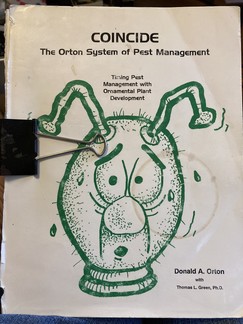
Growing degree days (GDD, or DD) may be the greatest tool devised for insect development monitoring and control since the 10X hand lens. And since the publishing of Don Orton’s book Coincide: The Orton System of Pest Management, the nursery and landscape industry has never looked back. When growing degree days are coupled with phenology, the task of insect pest management is simplified. (image on right of a well-used, first edition of Coincide, complete with binder clip to hold it together and a coffee ring, image credit: M. Wensing, DATCP)
Calculate GDD by adding the high and low temperatures of the day, then divide by 2. From this number minus 50. This gives you the GDD base 50 (B50). Total daily GDD to get the current degree days.
(High + Low) / 2 – 50 = GDD
There’s also a modified base 50 version. Below 50°F or above 86°F very little plant or insect development occurs. Any temperature below 50° becomes a 50 in the calculation and any high temperature above 86° becomes an 86. For insects that are active very early in the season, using a base 30 model may be better as it calculates early degree days that a base 50 or modified base 50 may miss.
What Orton (a former Illinois nursery inspector) did was correlate the GDDs with an easily visible plant development stage. For those of you who say, “I was told there would be no math,” the use of phenology reduces that need. Phenology (or phenomenology) is the study of biological events in time. Through phenology, we're able to correlate two coinciding events, such as that two-spotted spider mites can begin when Hydrangea arborescens is in early bloom.
Examples from Coincide of vulnerable pest life stage and degree days, along with a phenological indicator, include:
- Spruce spider mite eggs hatch at 650-950 GDD base 30 or, 100-200 GDD base 50. This correlates to Saucer magnolia in pink bud to early bloom.
- Pine needle scale crawlers are active at 1200-1600 GDD base 30 and 200-300 GDD base 50. This occurs when Vanhoutte spiraea is in bloom.
Using GDD and phenology, we target windows in time when we need to be actively out scouting for a known insect pest using our hand lens. The beauty of GDDs is that you can calculate and calibrate it for your local microclimate. Along Lake Michigan in Milwaukee, your degree days will vary significantly from those in Madison, despite being at a similar latitude. For those that don’t want to do math, consider utilizing any of the available degree day calculations done by DATCP or others (UMD Ext, Morton Arboretum, MSU, OSU BYGL) and/or learn your phenological indicators. Either way, the science of controlling and monitoring insect pests is improved using these tools!
|
_____________________________________
|
|
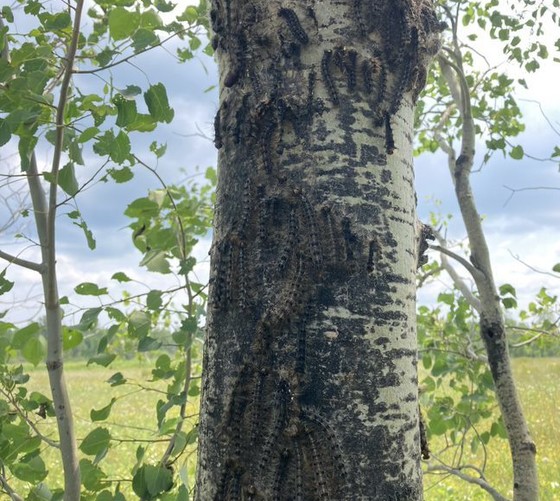 A tree heavily infested with spongy moth caterpillars | DATCP image
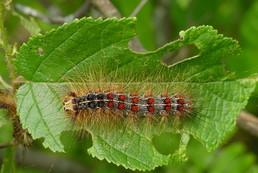
The United States Department of Agriculture has declared April 2023 Invasive Plant Pest and Disease Awareness Month. This national outreach month is dedicated to highlighting the impact invasive plant pests and diseases have on plant health nationwide and educating folks about actions they can take to help reduce their spread. In this edition, we're highlighting spongy moth, or Lymantria dispar. (Above left image is a spongy moth caterpillar, image credit: Bill McNee, WDNR)
Spongy moth caterpillars are fuzzy in appearance, with five pairs of blue bumps followed by six pairs of red bumps down the length of their back. They feed on oaks, crabapple, linden, willow, birch, aspen, and more than 300 other species of trees. Caterpillars hatch in April or May (around 100-200 GDD simple base 50) and feed through early July. During an outbreak, they can strip trees seemingly overnight. This mass defoliation can kill trees, making them an eyesore and a danger in your backyard, and an economically destructive force on the timber industry.
Last year marked the third consecutive year of population growth, with spongy moth traps catching roughly double the specimens throughout Wisconsin compared to in 2021. What will their population look like this year, and what causes this outbreak? Oddly enough, this could be a question for your local weatherperson!
Favorable weather conditions are generally accepted as the driving force behind Wisconsin’s recent population increase. Three consecutive years of warm, dry summers and relatively mild winters have limited the impacts of larval diseases and winter egg mass mortality, respectively. As a result, more caterpillars have been hatching and surviving to adulthood each year. The outbreak we have been experiencing is expected since spongy moth populations rise and fall in cycles about every 10 years, with the last spike happening around 2003. These population cycles occur from fluctuating predator-prey interactions.
One of the best natural controls is Entomophaga maimaiga, a fungal disease that kills spongy moth caterpillars by disrupting their digestive system. This fungus needs wet conditions to create spores that the spongy moth caterpillars ingest as they eat leaves. If the weather stays wet when spongy moth egg masses start hatching in May, then their population will likely be lower. Beyond this, DATCP, with the help of the USDA, runs an aerial spray program that is working to slow the spread of this pest from moving further west through the state. This is done by spraying Btk and mating disruptors. This spraying program is scheduled to start in May.
|
_____________________________________
|
|
 Bishop's goutweed, or snow-on-the-mountain, is a restricted invasive plant that cannot be sold in Wisconsin | DATCP L. Meils
Wisconsin DNR’s invasive species rule, known as NR 40, has been in place since 2009 and includes 68 prohibited, 63 restricted, and 14 split-listed invasive plants that can’t be legally sold or, in the case of prohibited plants, possessed. A much narrower subset of these have been commonly detected during inspections over the past 3 years, including Amur maple (Acer tataricum subsp. ginnala), Amur honeysuckle (Lonicera maackii), Bishop’s goutweed or snow-on-the mountain (Aegopodium podagraria), Chinese wisteria (Wisteria sinensis), lyme grass (Leymus arenarius), Burning bush (Euonymus alatus), Japanese barberry (specifically Rose Glow, Redleaf and Golden Carousel), Japanese honeysuckle (Lonicera japonica), woodland forget-me-not (Myosotis sylvatica) and ribbon grass (Phalaris arundinacea var. picta).
Although DATCP checks for NR 40 plants during nursery inspections, we refer situations requiring NR 40 enforcement to the DNR. The goal of all enforcement efforts is to encourage compliance so that harmful invasive plants are not introduced or spread into native habitats. Because we are well past the phase-out periods for all species and we have done extensive outreach on this rule, citations are likely for nurseries that continue to offer invasive plants for sale in 2023.
Keep in mind, NR40 restrictions apply not only to listed plant species, but also to hybrids, cultivars, subspecific taxa, seeds, propagules, and any other viable life-stages of listed species. This means that nursery stock marketed as being a “sterile” or “non-invasive” hybrid or cultivar may not be sold if the parent species is restricted or prohibited under NR 40, unless exemptions are spelled out in the rule, or unless an entity has a permit. For example, cultivars of Amur maple and Burning bush (Euonymous alatus) other than ‘Nordine’ can be sold in Wisconsin, even though their straight species are restricted. Conversely, Japanese barberry cultivars on the NR 40 plant list are restricted and can’t be sold, while other unlisted cultivars can. However, because barberry is regulated by the black stem rust quarantine, any barberry sold in Wisconsin must be non-invasive AND included on the list of disease resistant cultivars. Newly developed hybrids or cultivars that are bred to be sterile or non-invasive may be considered for exemptions in future revisions of NR 40, after evaluation by the DNR.
For nurseries shipping to other states, it is also crucial to understand invasive plant restrictions in other states by checking the national plant board regulatory summary. Admittedly, regulations can get confusing at times. It can be further complicated in situations where plants have synonyms, or are mislabeled, which is why improper labeling of plants is also a regulatory violation. When in doubt, contact DNR Organisms in Trade Specialist Liz Tanner at elizabeth.tanner@wisconsin.gov or (608) 225-8112.
_____________________________________
|
|
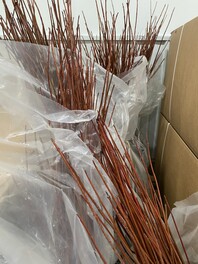
It’s a fact that many of the landscape-sized trees grown and planted in Wisconsin originate in Oregon. Orders for nursery stock are placed early the previous year, and then we cross our fingers and hope to get everything we have ordered. Each year can bring disappointments when the confirmations are sent or even when the doors of the delivery truck are opened. It’s frustrating to find some trees are missing from your order. Especially the lesser-used tree species such as American Hornbeam, Ohio Buckeye or American Smoketree - species promoted via the Diverse Urban Tree Species Survey, published in September 2022.
One option for nursery growers and dealers is to go online to www.nurseryguide.com, offered by the Oregon Association of Nurseries (OAN), where you can locate additional sources for buying trees. Before purchasing, be sure that you know where each tree was grown in order to be in compliance with any plant pest quarantines. For example, if you order hemlock trees grown in an area infested by hemlock woolly adelgid (HWA), you need to contact DATCP staff to set up a Compliance Agreement in advance to reduce risks of introducing that pest into Wisconsin. To learn more about HWA compliance agreements, check out the March issue of WGO.
Another good resource is the list of Wisconsin’s licensed nursery growers, which is available on DATCP’s website. Although you can’t see exactly what tree species are available, many larger growers have catalogs and inventory information on their websites.
-Contributing author Jeff Edgar, Silver Creek Nurseries and member of the Wisconsin Urban Forestry Council
|
_____________________________________
|
|
|
|
|